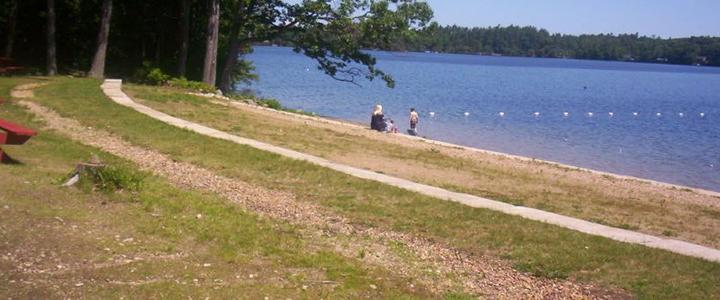
Looking back: popular Deerfield beach restored
As the summer days heat up and people flock to the newly reopened beaches to cool off, it is worth a look back to see how a popular beach in Deerfield was restored after elevated levels of E. coli landed it on the Clean Water Act (CWA) impaired waters list.
NHDES water quality monitoring of Pleasant Lake showed exceedances of the E. coli bacteria water quality standard. Bacteria from a failed septic system and sediments from chronic erosion were impacting recreation at Veasey Park Beach, a popular summer recreation destination in Deerfield. Two portable toilets were brought in, costing $1,000 per season to operate, but replacing the conventional septic system would have cost over $25,000, and posed technical and logistical challenges. Areas of Veasey Park Beach were experiencing significant erosion as well. The Town of Deerfield, with support from other partners, installed composting toilets in the new beach bathhouse and added erosion control practices to redirect and infiltrate runoff. As a result of this work, Veasey Park Beach at Pleasant Lake now meets state water quality standards.
Story Highlights
Veasey Park, Deerfield’s only waterfront town park, is on the west shore of Pleasant Lake. It is a very popular facility during summer months, with lake access for residents and swimming lessons for children. In 2004, two composting toilets were installed at Veasey Park. In such a highly used facility, construction of a well-designed bathhouse with composting toilets was chosen as an environmental alternative to a conventional septic system, offering: (1) a low-impact and cost-effective replacement for the failed septic system at the town park and (2) a demonstrated alternative septic system installation. The project also served as a demonstration project for the area. Because of the topography, underlying geology, and private property density, there are limited opportunities for community septic systems around the lake; the composting toilets installed at Veasey Park provided an example for lakeshore residents to consider as their septic systems age and require repairs, replacements or upgrades—or as seasonal homes are converted to year-round residences. In addition to the bathhouse, a three-phase project was completed to reduce the amount of stormwater and sediment running off the beach into Pleasant Lake. The first phase reduced stormwater runoff toward the beach from the west by grading a gravel parking lot and installing drainage diverters. The second phase reduced beach erosion and sediment deposition into the lake by grading and installing low-rise retaining walls to create three perched beach-sand terraces. Existing overland runoff was diverted around the beach into the well-vegetated forest floor where stormwater could infiltrate. The third phase included installing an interceptor main line and lateral drains behind each of the two retaining walls to manage subsurface flows that were causing erosion.
Results
Since the composting toilet and other best management practices were installed at the Deerfield Town Beach/Veasey Park Beach in 2004, only three exceedances have occurred – out of 120 bacteria samples collected – and were just over the freshwater bacteria standard. These exceedances are attributed to wildlife and stormwater runoff rather than direct human sources. Two of the exceedances were gathered after rain events, when many surface waters experience elevated bacteria counts of limited duration – unlike a persistent source of fecal contamination that would occur in both dry and wet weather. As a result, Veasey Park Beach was removed from the CWA impaired waters list in 2014. The removal highlights the success of the project in 2004 that removed the failed septic system, which had been a direct, consistent and concentrated source of E. coli bacteria to the beach and lake.
Partners and Funding
This project relied on cooperation from partners in Deerfield, including the Veasey Park Commission, the town’s Conservation Commission, members of the Select Board and Zoning Board, and the Pleasant Lake Preservation Association. EPA and NHDES provided support for the Veasey Park Commission Town Beach Erosion Control Plan and Pleasant Lake Diagnostic Study, which was funded with $11,000 in CWA section 319 funds and $6,800 in matching funds. The combined cost of the project was $85,000, with $25,000 in CWA section 319 funds and close to $60,000 in matching funds to complete the work.




